A Critique of Research Methodology: Employee Motivation at Hospital
VerifiedAdded on 2022/09/14
|6
|1483
|27
Report
AI Summary
This report offers a critical evaluation of the research methodology employed to investigate the relationship between performance appraisals, incentives, and employee motivation at Royal Prince Alfred Hospital. The study utilizes an ex-post-facto survey design, collecting data through questionnaires with a Likert scale from a sample of 2100 employees. The methodology aims to determine the correlation between performance appraisals/incentives (independent variable) and employee motivation (dependent variable), analyzing data using multiple regression analysis, frequencies, and percentages. The critique discusses the strengths and limitations of this approach, including the inability to manipulate the independent variable directly, potential biases in random sampling, and the reliance on questionnaires. The report acknowledges the value of the chosen methodology while pointing out potential drawbacks such as the challenges in establishing a direct causal relationship and the possibility of biased responses. The analysis considers the reliability of the data collection instruments and the overall suitability of the methodology in addressing the research question. The report concludes by summarizing the key points of the methodology and its potential implications for the study's findings.
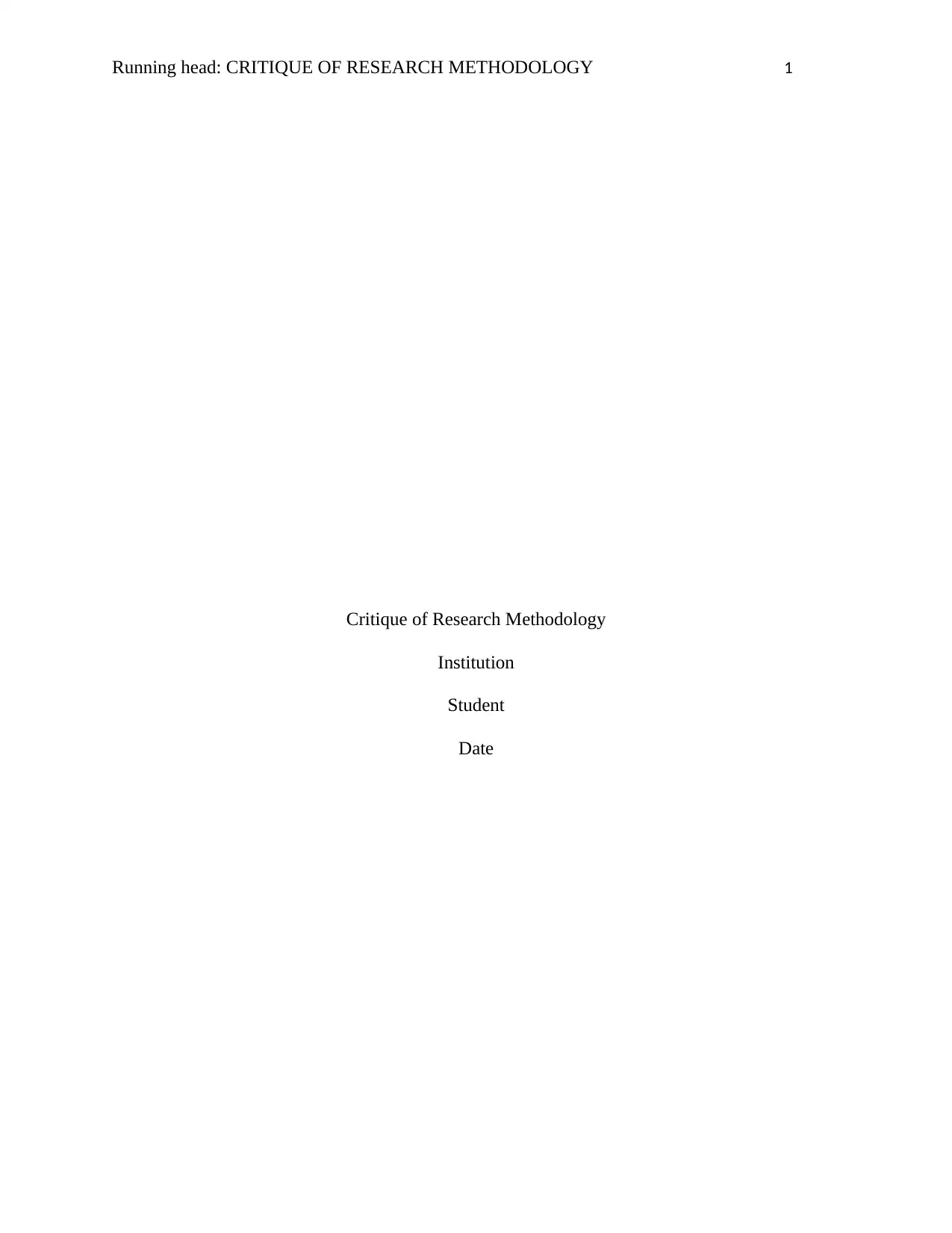
Running head: CRITIQUE OF RESEARCH METHODOLOGY 1
Critique of Research Methodology
Institution
Student
Date
Critique of Research Methodology
Institution
Student
Date
Paraphrase This Document
Need a fresh take? Get an instant paraphrase of this document with our AI Paraphraser
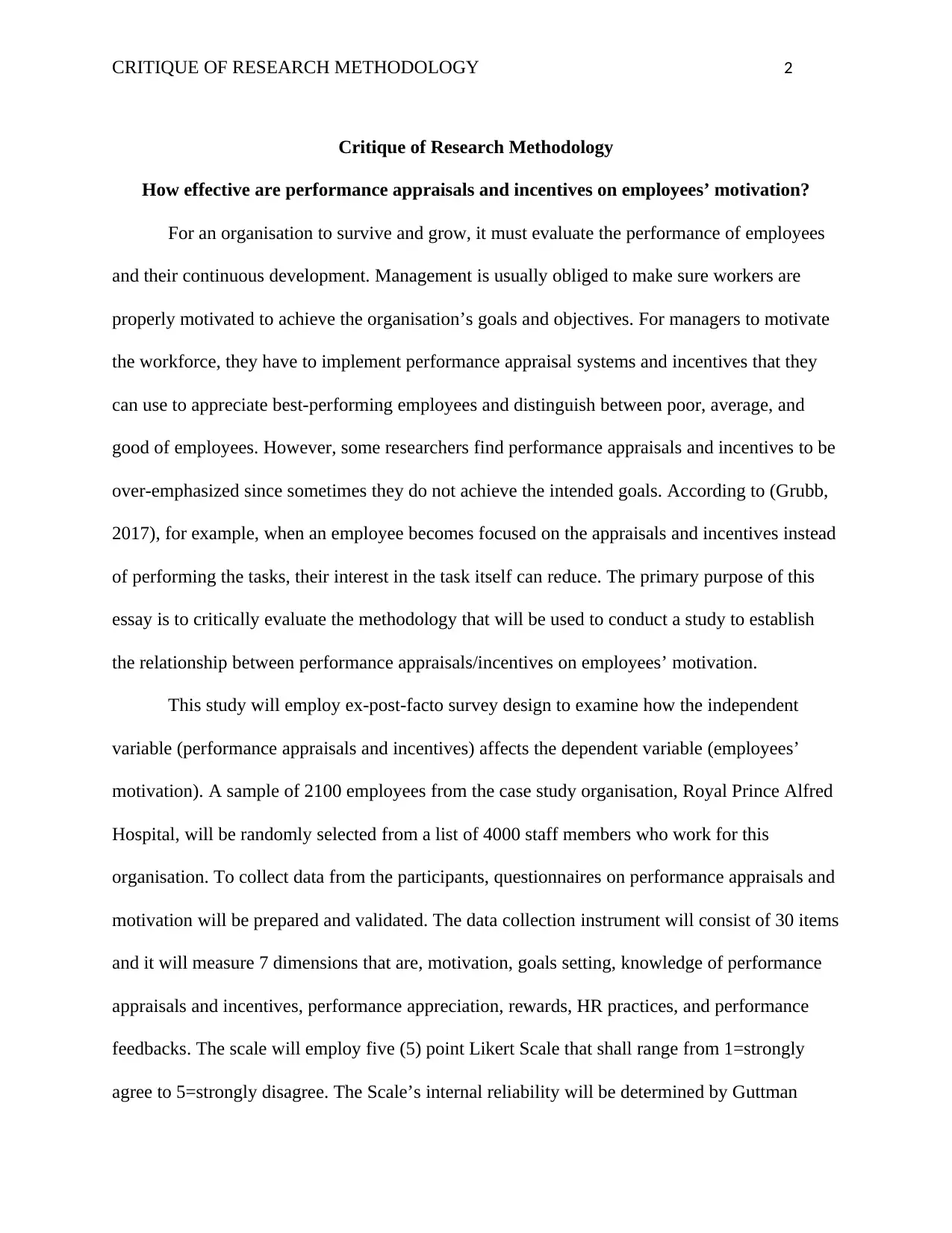
CRITIQUE OF RESEARCH METHODOLOGY 2
Critique of Research Methodology
How effective are performance appraisals and incentives on employees’ motivation?
For an organisation to survive and grow, it must evaluate the performance of employees
and their continuous development. Management is usually obliged to make sure workers are
properly motivated to achieve the organisation’s goals and objectives. For managers to motivate
the workforce, they have to implement performance appraisal systems and incentives that they
can use to appreciate best-performing employees and distinguish between poor, average, and
good of employees. However, some researchers find performance appraisals and incentives to be
over-emphasized since sometimes they do not achieve the intended goals. According to (Grubb,
2017), for example, when an employee becomes focused on the appraisals and incentives instead
of performing the tasks, their interest in the task itself can reduce. The primary purpose of this
essay is to critically evaluate the methodology that will be used to conduct a study to establish
the relationship between performance appraisals/incentives on employees’ motivation.
This study will employ ex-post-facto survey design to examine how the independent
variable (performance appraisals and incentives) affects the dependent variable (employees’
motivation). A sample of 2100 employees from the case study organisation, Royal Prince Alfred
Hospital, will be randomly selected from a list of 4000 staff members who work for this
organisation. To collect data from the participants, questionnaires on performance appraisals and
motivation will be prepared and validated. The data collection instrument will consist of 30 items
and it will measure 7 dimensions that are, motivation, goals setting, knowledge of performance
appraisals and incentives, performance appreciation, rewards, HR practices, and performance
feedbacks. The scale will employ five (5) point Likert Scale that shall range from 1=strongly
agree to 5=strongly disagree. The Scale’s internal reliability will be determined by Guttman
Critique of Research Methodology
How effective are performance appraisals and incentives on employees’ motivation?
For an organisation to survive and grow, it must evaluate the performance of employees
and their continuous development. Management is usually obliged to make sure workers are
properly motivated to achieve the organisation’s goals and objectives. For managers to motivate
the workforce, they have to implement performance appraisal systems and incentives that they
can use to appreciate best-performing employees and distinguish between poor, average, and
good of employees. However, some researchers find performance appraisals and incentives to be
over-emphasized since sometimes they do not achieve the intended goals. According to (Grubb,
2017), for example, when an employee becomes focused on the appraisals and incentives instead
of performing the tasks, their interest in the task itself can reduce. The primary purpose of this
essay is to critically evaluate the methodology that will be used to conduct a study to establish
the relationship between performance appraisals/incentives on employees’ motivation.
This study will employ ex-post-facto survey design to examine how the independent
variable (performance appraisals and incentives) affects the dependent variable (employees’
motivation). A sample of 2100 employees from the case study organisation, Royal Prince Alfred
Hospital, will be randomly selected from a list of 4000 staff members who work for this
organisation. To collect data from the participants, questionnaires on performance appraisals and
motivation will be prepared and validated. The data collection instrument will consist of 30 items
and it will measure 7 dimensions that are, motivation, goals setting, knowledge of performance
appraisals and incentives, performance appreciation, rewards, HR practices, and performance
feedbacks. The scale will employ five (5) point Likert Scale that shall range from 1=strongly
agree to 5=strongly disagree. The Scale’s internal reliability will be determined by Guttman
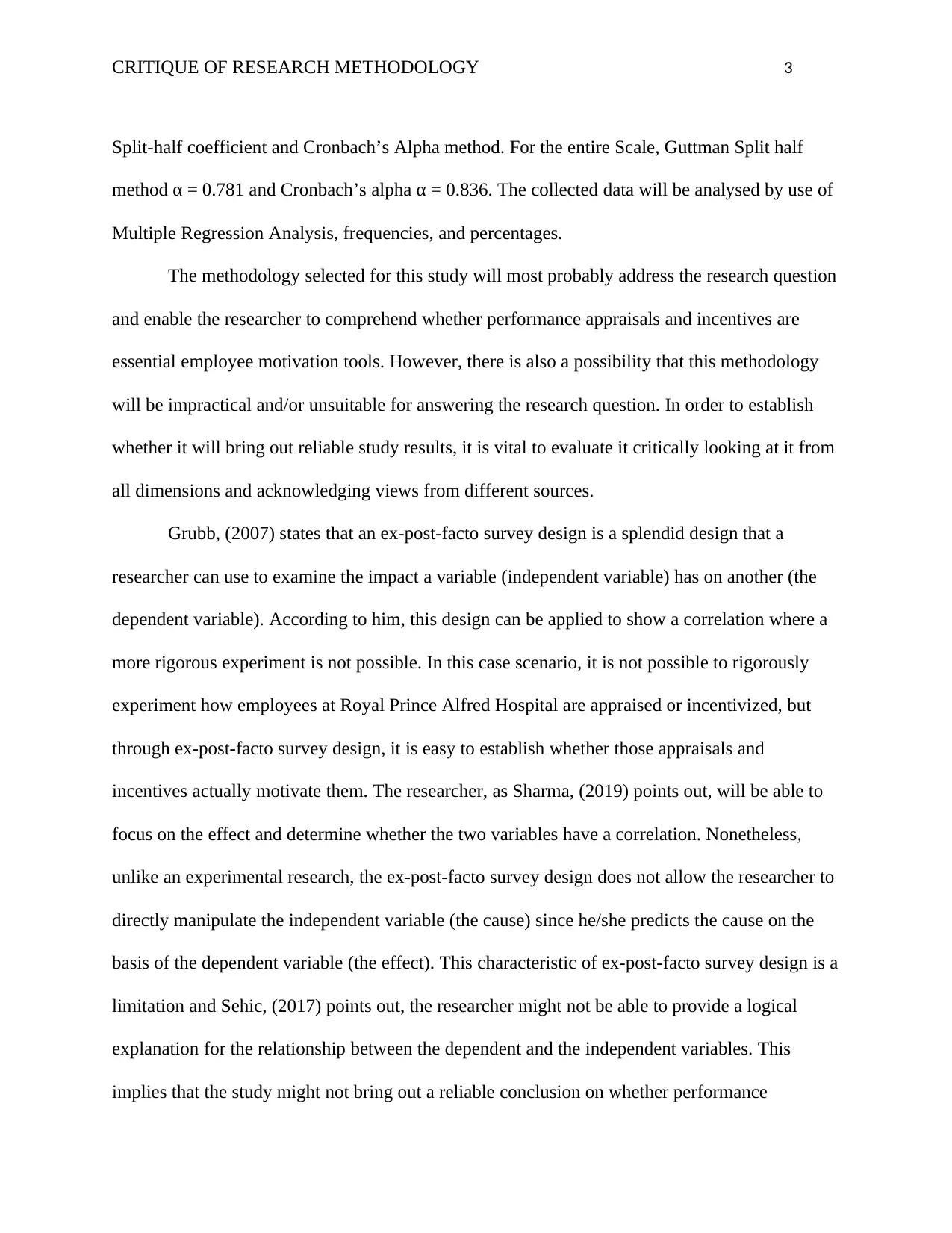
CRITIQUE OF RESEARCH METHODOLOGY 3
Split-half coefficient and Cronbach’s Alpha method. For the entire Scale, Guttman Split half
method α = 0.781 and Cronbach’s alpha α = 0.836. The collected data will be analysed by use of
Multiple Regression Analysis, frequencies, and percentages.
The methodology selected for this study will most probably address the research question
and enable the researcher to comprehend whether performance appraisals and incentives are
essential employee motivation tools. However, there is also a possibility that this methodology
will be impractical and/or unsuitable for answering the research question. In order to establish
whether it will bring out reliable study results, it is vital to evaluate it critically looking at it from
all dimensions and acknowledging views from different sources.
Grubb, (2007) states that an ex-post-facto survey design is a splendid design that a
researcher can use to examine the impact a variable (independent variable) has on another (the
dependent variable). According to him, this design can be applied to show a correlation where a
more rigorous experiment is not possible. In this case scenario, it is not possible to rigorously
experiment how employees at Royal Prince Alfred Hospital are appraised or incentivized, but
through ex-post-facto survey design, it is easy to establish whether those appraisals and
incentives actually motivate them. The researcher, as Sharma, (2019) points out, will be able to
focus on the effect and determine whether the two variables have a correlation. Nonetheless,
unlike an experimental research, the ex-post-facto survey design does not allow the researcher to
directly manipulate the independent variable (the cause) since he/she predicts the cause on the
basis of the dependent variable (the effect). This characteristic of ex-post-facto survey design is a
limitation and Sehic, (2017) points out, the researcher might not be able to provide a logical
explanation for the relationship between the dependent and the independent variables. This
implies that the study might not bring out a reliable conclusion on whether performance
Split-half coefficient and Cronbach’s Alpha method. For the entire Scale, Guttman Split half
method α = 0.781 and Cronbach’s alpha α = 0.836. The collected data will be analysed by use of
Multiple Regression Analysis, frequencies, and percentages.
The methodology selected for this study will most probably address the research question
and enable the researcher to comprehend whether performance appraisals and incentives are
essential employee motivation tools. However, there is also a possibility that this methodology
will be impractical and/or unsuitable for answering the research question. In order to establish
whether it will bring out reliable study results, it is vital to evaluate it critically looking at it from
all dimensions and acknowledging views from different sources.
Grubb, (2007) states that an ex-post-facto survey design is a splendid design that a
researcher can use to examine the impact a variable (independent variable) has on another (the
dependent variable). According to him, this design can be applied to show a correlation where a
more rigorous experiment is not possible. In this case scenario, it is not possible to rigorously
experiment how employees at Royal Prince Alfred Hospital are appraised or incentivized, but
through ex-post-facto survey design, it is easy to establish whether those appraisals and
incentives actually motivate them. The researcher, as Sharma, (2019) points out, will be able to
focus on the effect and determine whether the two variables have a correlation. Nonetheless,
unlike an experimental research, the ex-post-facto survey design does not allow the researcher to
directly manipulate the independent variable (the cause) since he/she predicts the cause on the
basis of the dependent variable (the effect). This characteristic of ex-post-facto survey design is a
limitation and Sehic, (2017) points out, the researcher might not be able to provide a logical
explanation for the relationship between the dependent and the independent variables. This
implies that the study might not bring out a reliable conclusion on whether performance
⊘ This is a preview!⊘
Do you want full access?
Subscribe today to unlock all pages.

Trusted by 1+ million students worldwide
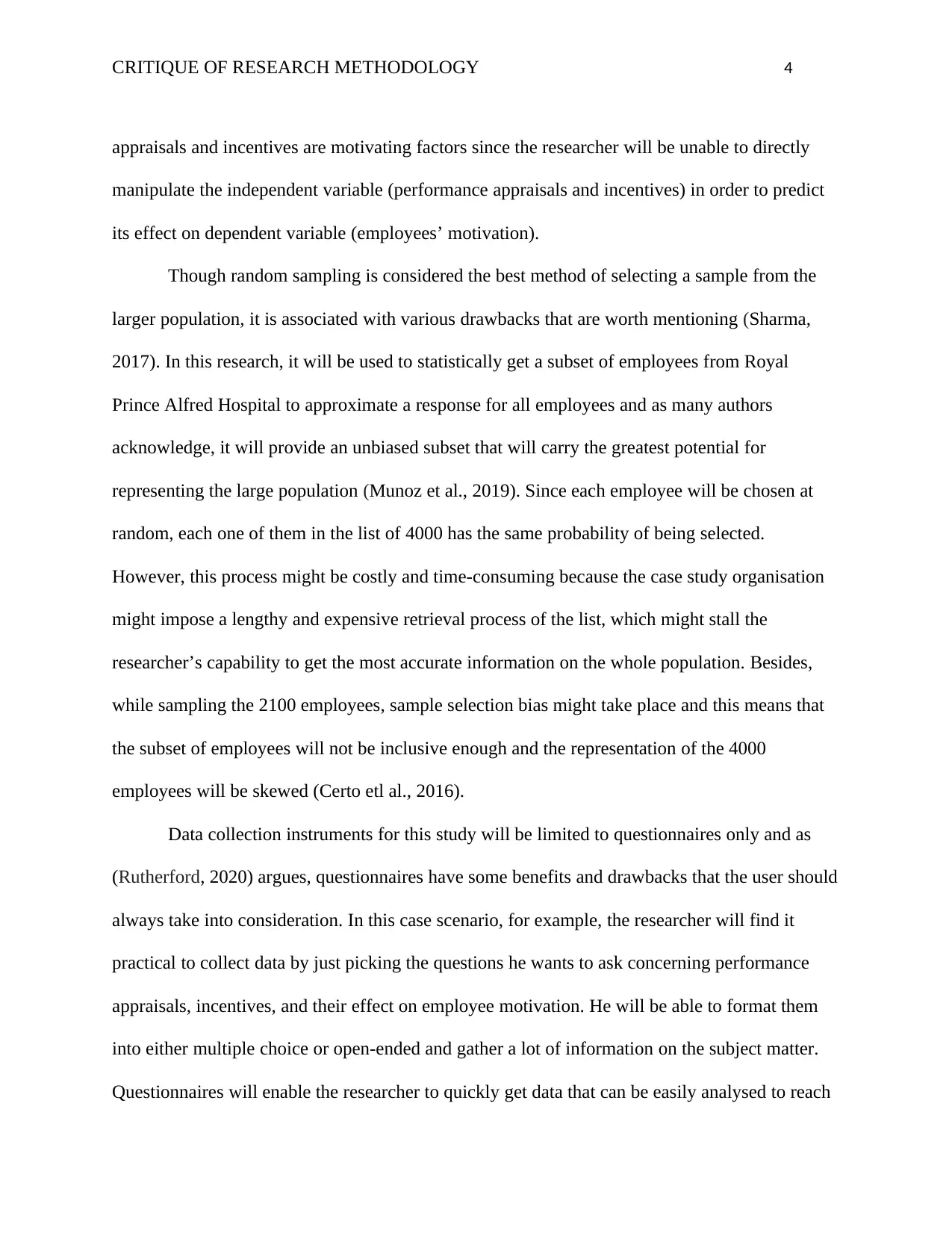
CRITIQUE OF RESEARCH METHODOLOGY 4
appraisals and incentives are motivating factors since the researcher will be unable to directly
manipulate the independent variable (performance appraisals and incentives) in order to predict
its effect on dependent variable (employees’ motivation).
Though random sampling is considered the best method of selecting a sample from the
larger population, it is associated with various drawbacks that are worth mentioning (Sharma,
2017). In this research, it will be used to statistically get a subset of employees from Royal
Prince Alfred Hospital to approximate a response for all employees and as many authors
acknowledge, it will provide an unbiased subset that will carry the greatest potential for
representing the large population (Munoz et al., 2019). Since each employee will be chosen at
random, each one of them in the list of 4000 has the same probability of being selected.
However, this process might be costly and time-consuming because the case study organisation
might impose a lengthy and expensive retrieval process of the list, which might stall the
researcher’s capability to get the most accurate information on the whole population. Besides,
while sampling the 2100 employees, sample selection bias might take place and this means that
the subset of employees will not be inclusive enough and the representation of the 4000
employees will be skewed (Certo etl al., 2016).
Data collection instruments for this study will be limited to questionnaires only and as
(Rutherford, 2020) argues, questionnaires have some benefits and drawbacks that the user should
always take into consideration. In this case scenario, for example, the researcher will find it
practical to collect data by just picking the questions he wants to ask concerning performance
appraisals, incentives, and their effect on employee motivation. He will be able to format them
into either multiple choice or open-ended and gather a lot of information on the subject matter.
Questionnaires will enable the researcher to quickly get data that can be easily analysed to reach
appraisals and incentives are motivating factors since the researcher will be unable to directly
manipulate the independent variable (performance appraisals and incentives) in order to predict
its effect on dependent variable (employees’ motivation).
Though random sampling is considered the best method of selecting a sample from the
larger population, it is associated with various drawbacks that are worth mentioning (Sharma,
2017). In this research, it will be used to statistically get a subset of employees from Royal
Prince Alfred Hospital to approximate a response for all employees and as many authors
acknowledge, it will provide an unbiased subset that will carry the greatest potential for
representing the large population (Munoz et al., 2019). Since each employee will be chosen at
random, each one of them in the list of 4000 has the same probability of being selected.
However, this process might be costly and time-consuming because the case study organisation
might impose a lengthy and expensive retrieval process of the list, which might stall the
researcher’s capability to get the most accurate information on the whole population. Besides,
while sampling the 2100 employees, sample selection bias might take place and this means that
the subset of employees will not be inclusive enough and the representation of the 4000
employees will be skewed (Certo etl al., 2016).
Data collection instruments for this study will be limited to questionnaires only and as
(Rutherford, 2020) argues, questionnaires have some benefits and drawbacks that the user should
always take into consideration. In this case scenario, for example, the researcher will find it
practical to collect data by just picking the questions he wants to ask concerning performance
appraisals, incentives, and their effect on employee motivation. He will be able to format them
into either multiple choice or open-ended and gather a lot of information on the subject matter.
Questionnaires will enable the researcher to quickly get data that can be easily analysed to reach
Paraphrase This Document
Need a fresh take? Get an instant paraphrase of this document with our AI Paraphraser
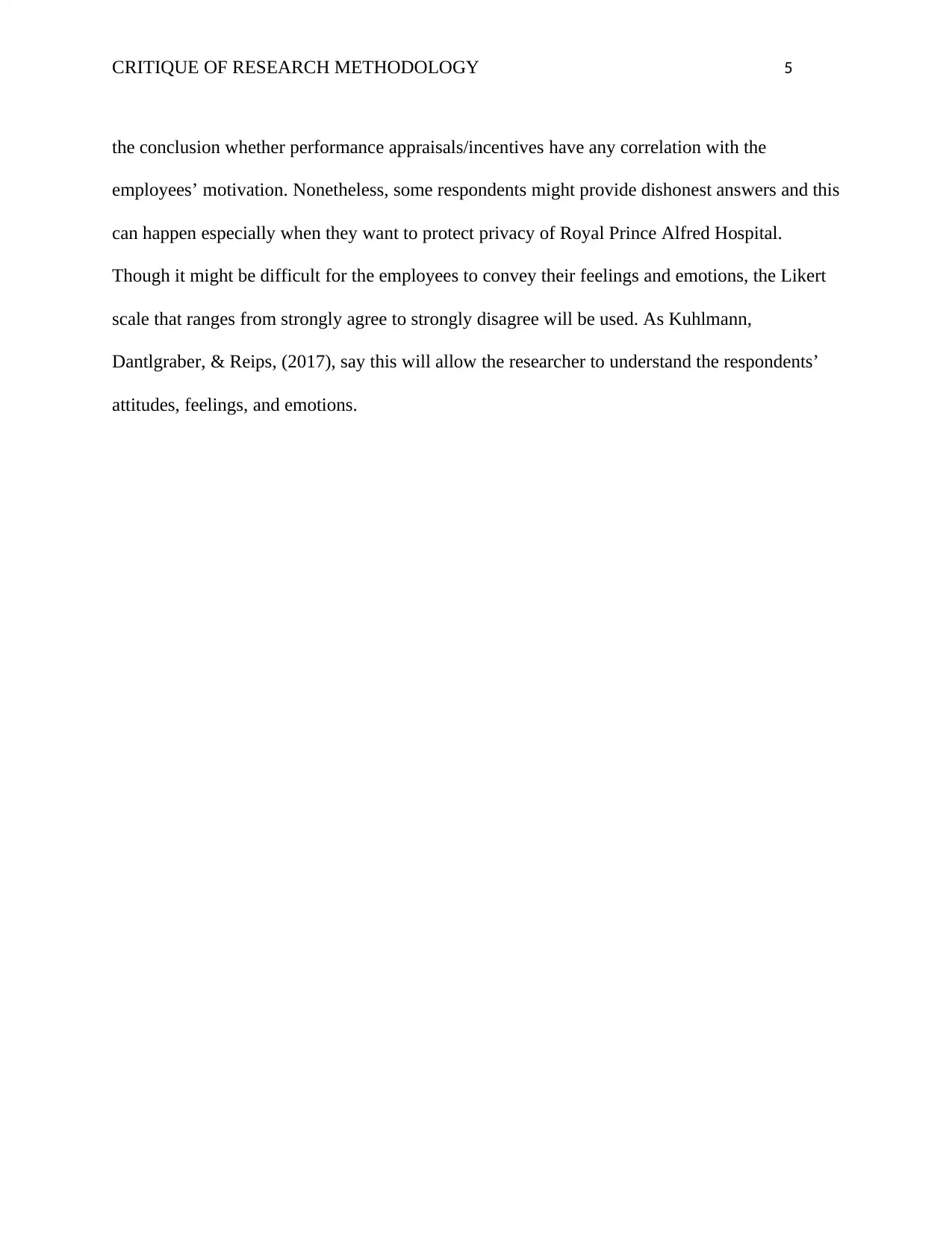
CRITIQUE OF RESEARCH METHODOLOGY 5
the conclusion whether performance appraisals/incentives have any correlation with the
employees’ motivation. Nonetheless, some respondents might provide dishonest answers and this
can happen especially when they want to protect privacy of Royal Prince Alfred Hospital.
Though it might be difficult for the employees to convey their feelings and emotions, the Likert
scale that ranges from strongly agree to strongly disagree will be used. As Kuhlmann,
Dantlgraber, & Reips, (2017), say this will allow the researcher to understand the respondents’
attitudes, feelings, and emotions.
the conclusion whether performance appraisals/incentives have any correlation with the
employees’ motivation. Nonetheless, some respondents might provide dishonest answers and this
can happen especially when they want to protect privacy of Royal Prince Alfred Hospital.
Though it might be difficult for the employees to convey their feelings and emotions, the Likert
scale that ranges from strongly agree to strongly disagree will be used. As Kuhlmann,
Dantlgraber, & Reips, (2017), say this will allow the researcher to understand the respondents’
attitudes, feelings, and emotions.
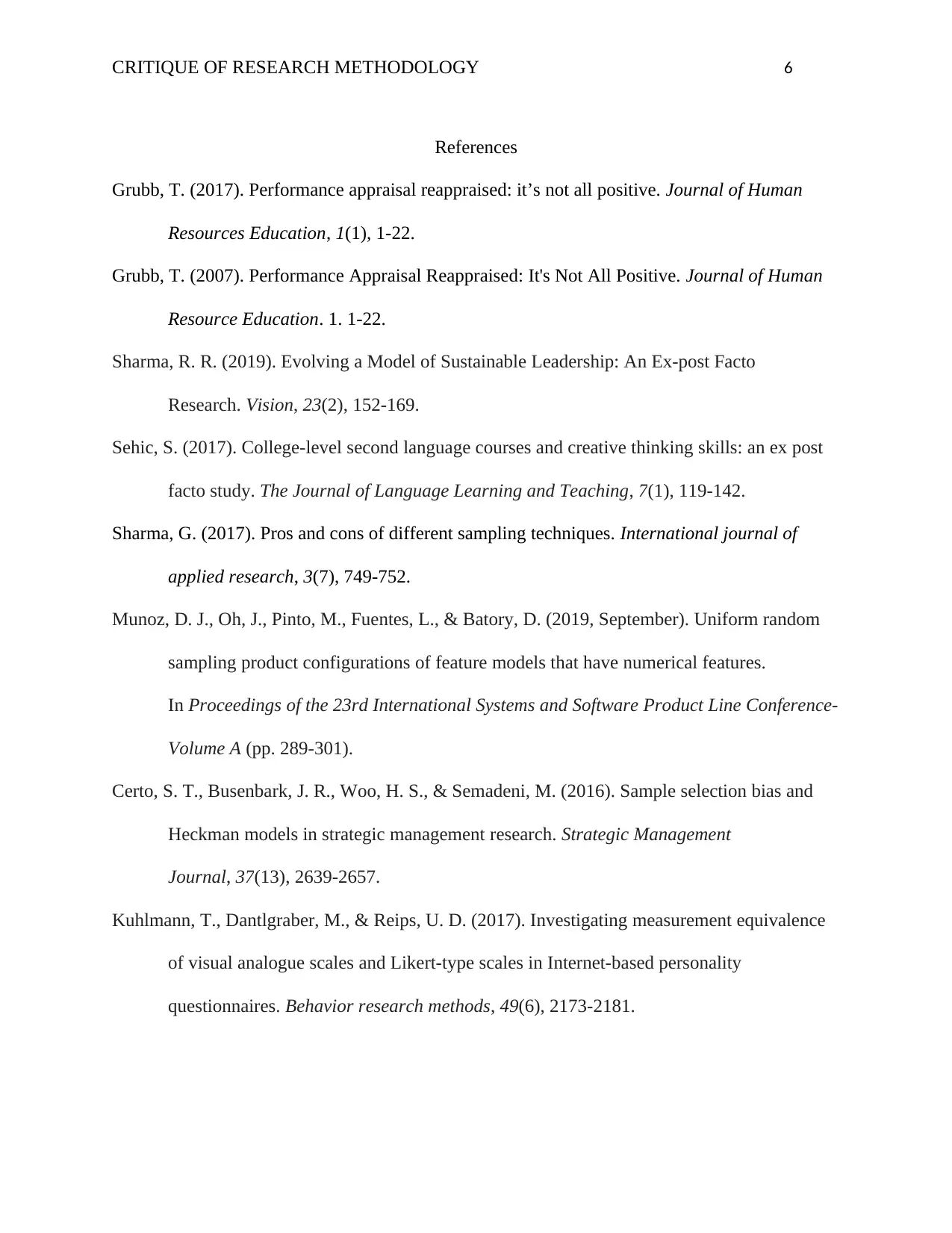
CRITIQUE OF RESEARCH METHODOLOGY 6
References
Grubb, T. (2017). Performance appraisal reappraised: it’s not all positive. Journal of Human
Resources Education, 1(1), 1-22.
Grubb, T. (2007). Performance Appraisal Reappraised: It's Not All Positive. Journal of Human
Resource Education. 1. 1-22.
Sharma, R. R. (2019). Evolving a Model of Sustainable Leadership: An Ex-post Facto
Research. Vision, 23(2), 152-169.
Sehic, S. (2017). College-level second language courses and creative thinking skills: an ex post
facto study. The Journal of Language Learning and Teaching, 7(1), 119-142.
Sharma, G. (2017). Pros and cons of different sampling techniques. International journal of
applied research, 3(7), 749-752.
Munoz, D. J., Oh, J., Pinto, M., Fuentes, L., & Batory, D. (2019, September). Uniform random
sampling product configurations of feature models that have numerical features.
In Proceedings of the 23rd International Systems and Software Product Line Conference-
Volume A (pp. 289-301).
Certo, S. T., Busenbark, J. R., Woo, H. S., & Semadeni, M. (2016). Sample selection bias and
Heckman models in strategic management research. Strategic Management
Journal, 37(13), 2639-2657.
Kuhlmann, T., Dantlgraber, M., & Reips, U. D. (2017). Investigating measurement equivalence
of visual analogue scales and Likert-type scales in Internet-based personality
questionnaires. Behavior research methods, 49(6), 2173-2181.
References
Grubb, T. (2017). Performance appraisal reappraised: it’s not all positive. Journal of Human
Resources Education, 1(1), 1-22.
Grubb, T. (2007). Performance Appraisal Reappraised: It's Not All Positive. Journal of Human
Resource Education. 1. 1-22.
Sharma, R. R. (2019). Evolving a Model of Sustainable Leadership: An Ex-post Facto
Research. Vision, 23(2), 152-169.
Sehic, S. (2017). College-level second language courses and creative thinking skills: an ex post
facto study. The Journal of Language Learning and Teaching, 7(1), 119-142.
Sharma, G. (2017). Pros and cons of different sampling techniques. International journal of
applied research, 3(7), 749-752.
Munoz, D. J., Oh, J., Pinto, M., Fuentes, L., & Batory, D. (2019, September). Uniform random
sampling product configurations of feature models that have numerical features.
In Proceedings of the 23rd International Systems and Software Product Line Conference-
Volume A (pp. 289-301).
Certo, S. T., Busenbark, J. R., Woo, H. S., & Semadeni, M. (2016). Sample selection bias and
Heckman models in strategic management research. Strategic Management
Journal, 37(13), 2639-2657.
Kuhlmann, T., Dantlgraber, M., & Reips, U. D. (2017). Investigating measurement equivalence
of visual analogue scales and Likert-type scales in Internet-based personality
questionnaires. Behavior research methods, 49(6), 2173-2181.
⊘ This is a preview!⊘
Do you want full access?
Subscribe today to unlock all pages.

Trusted by 1+ million students worldwide
1 out of 6
Your All-in-One AI-Powered Toolkit for Academic Success.
+13062052269
info@desklib.com
Available 24*7 on WhatsApp / Email
![[object Object]](/_next/static/media/star-bottom.7253800d.svg)
Unlock your academic potential
Copyright © 2020–2025 A2Z Services. All Rights Reserved. Developed and managed by ZUCOL.